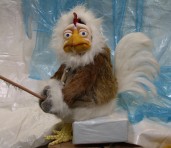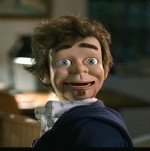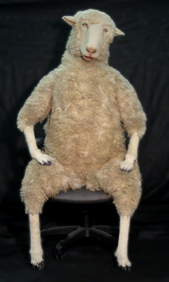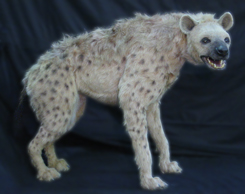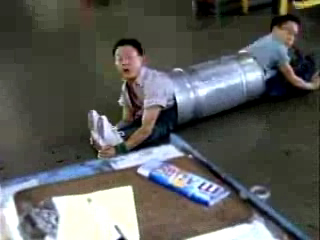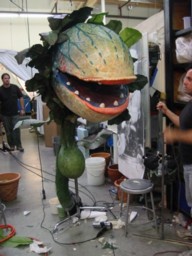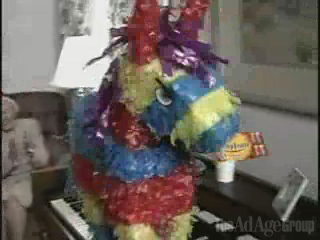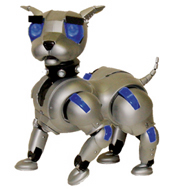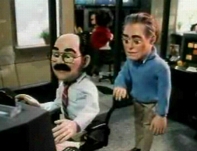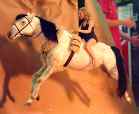| |
|
|
|
|
Puppets Puppet: A replica of a human, animal, creature, or other character, made to move and "brought to life" by a puppeteer's manipulations. Here at TCS, puppetry plays an enormous part in bringing our characters to life. Virtually all of our creations employ some form of puppetry, from the highest-tech Waldo®-controlled animatronic puppet to low-tech non-animatronic Handpuppets. At their simplest, Puppets are performed with a hand directly inside a character's head. Add limb movements, and you'll need rods. Add facial expressions, and you'll need radio controlled or cable animatronic mechanisms. Need a full body movement and locomottion? Then you'll probably need a Bunraku technique, where the operator is directly behind the puppet (as used in our Plato and Perdue Muscle Chicken, and Collector characters) wearing a green, blue, black, or red suit, and eliminated in post production. (Clicking links will take you to a larger version or a page detailing the work)
Apple iMac Ad:
Foster Farms Chickens:
Wilson Golf Ball Gopher:
Ironically, the new technology of "painting out" extraneous imagery via computer graphics allows us to operate many of our puppets the old-fashioned way - via directly linked exterior rods. Rods provide the ultimate control over the puppet - easily superior to cable or mechanically operated characters - and the rods (and even puppeteers!) are simply "erased" from the final film. (See the description of our "collector" puppets below.) It's the most effective and powerful form of puppetry I can think of.
Collector bunraku puppet:
Sarah Jessica Parker Witch puppet:
Duracell boxers:
Interestingly, these puppets became the center of debate between the producers who commissioned them and SAG, the Screen Actor's Guild, which represents puppeteers (remember: puppeteers are actors, too!) The producers tried to avoid having to pay residuals, and would not agree that these were puppets, trying to call them "electronic action props." They pointed to an outdated language in the SAG/Producer's agreement, which defined puppets as being operated by "hand, rod, stick, or string." An arbitration took place in which a demonstration proved, despite the existence of electronic gimmickry, that the puppets were indeed manipulated by a puppeteer's hand movements. The arbitrator found in favor of SAG and the puppeteers, opening the language of the agreement to embrace new forms of technology that enable puppetry. Horse Puppet:
Advances in the technical end of human/machine puppet interfaces have led to the possibility for "electronic puppetry". The same devices we use in real-time control of our animatronic puppets have been, and are used, to send data to high-powered computers, which take the movement data collected by a Waldo® and update the movements of completely computer-generated images This concept is called performance capture and animation, and it may be used to simple capture key frames, or entire real-time sequences of animation.
Theater Ghost:
Budweiser frogs:
Regardless of the technology used, the most important thing we keep in mind when delivering a creature to set is the believability of its performance. The individual or team assigned to one of our puppets is made aware that it's an acting job they are required to do. They must be passionate, they must "get into" that character, as any actor would, no matter if it's a chicken, robot, monster, or alien. Our goal is to make the technology as transparent as possible, keeping the number of obstacles between the performer's manipulation and a life-like performance to a minimum. What results, with the help of the director, cameraman, and editor, is that we have created our illusion properly. We weave our spell, the audience falls into a willing suspension of disbelief, and we have "brought to life" a new character.
 Super Mario:One of the world's first "electronic
puppets". Using a custom designed TCS Facial
Waldo® and a suite of proprietary hard- and software,
SimGraphics Corp. created this real-time animatable Super Mario character
for use in Nintendo kiosks and commercials worldwide.
Super Mario:One of the world's first "electronic
puppets". Using a custom designed TCS Facial
Waldo® and a suite of proprietary hard- and software,
SimGraphics Corp. created this real-time animatable Super Mario character
for use in Nintendo kiosks and commercials worldwide.(See our Waldo® page for more exciting developments in this area.) The human hand will always provide the most dexterous, direct form of puppet movement - whenever we can use a person's hand to manipulate a movement or expression, we'll do it. But some creatures are too small to accommodate a human hand, or there are too many functions for a single hand to operate; in which case we use cable or radio-controlled mechanisms. Other creatures are very large, and human hands may not have the power to move the puppet at all. In these cases we use powerful electric linear actuators, air or hydraulic cylinders, or giant servos. These complex systems also require sophisticated control interfaces, such as the Waldo® or other telemetry-based devices. But in all cases, our most important consideration is not the technique, but the performance. That's the only thing the audience will see, after all. (It's only here that you can get a glimpse behind the scenes!) Home What's New | Features | Commercials | Resume | Realistic | Whimsical | Scary | Animatronics | Prosthetics | Puppets | Waldo ® | Publicity | TCS Fun | FX FAQ | Reference | Contact Us Except where noted, all contents are the property of The Character Shop, Inc. and copyright 1995-2006 |

